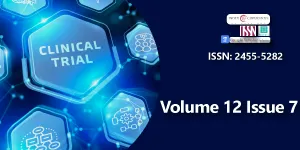A Comprehensive Review of Schnitzler Syndrome
Main Article Content
Abstract
Abstract
Schnitzler syndrome is a rare disorder characterized by a chronic red, hive-like rash and elevated levels of a specific protein in the blood (monoclonal IgM gammopathy). Symptoms associated with Schnitzler syndrome may include recurrent bouts of fever, inflammation of the joints (arthritis), joint pain (arthralgia), bone pain, and other findings such as enlarged lymph nodes (lymphadenopathy). Most cases of Schnitzler syndrome have a chronic, benign course. However, over a 10-year period, approximately 15% of people with the condition develop cancer, often caused by an overproduction of white blood cells (lymphoproliferative disorders) such as Waldenström macroglobulinemia. The exact cause of Schnitzler syndrome is unknown. Researchers believe that certain parts of the immune system may not function properly, ultimately causing Schnitzler syndrome. People with Schnitzler syndrome also have a clinical finding called monoclonal IgM gammopathy, in which abnormalities affecting the production of immunoglobulins lead to increased levels of immunoglobulin M (IgM) in the body. The first-line treatment for mild cases is nonsteroidal anti-inflammatory drugs (NSAIDs). But this is often not enough. In more severe cases, standard treatment is with therapy to inhibit the cytokine IL-1.
Downloads
Article Details
Copyright (c) 2025 Asadi S, et al.

This work is licensed under a Creative Commons Attribution 4.0 International License.
Asadi S, Human Idiopathic Diseases Books (4 vol, 3200 pages), Amidi Publications, 2025.
Rowczenio DM, Pathak S, Arostegui JI, Mensa-Vilaro A, Omoyinmi E, Brogan P, et al. Molecular genetic investigation, clinical features, and response to treatment in 21 patients with Schnitzler syndrome. Blood 2018 Mar 1;131(9):974-981. Available from: https://doi.org/10.1182/blood-2017-10-810366
Krause K, Tsianakas A, Wagner N, Fischer J, Weller K, Metz M, et al. Efficacy and safety of canakinumab in Schnitzler syndrome: A multicenter randomized placebo-controlled study. J Allergy Clin Immunol. 2017 Apr;139(4):1311-1320. Available from: https://doi.org/10.1016/j.jaci.2016.07.041
Krause K, Feist E, Fiene M, Kallinich T, Maurer M. Complete remission in 3 of 3 anti-IL-6 treated patients with Schnitzler syndrome. J.Allergy Clin.Immunol. J Allergy Clin Immunol. 2012;129(3):848-50. Available from: https://doi.org/10.1016/j.jaci.2011.10.031
de Koning HD, Schalkwijk J, van der Meer JW, Simon A. Successful canakinumab treatment identifies IL-1beta as a pivotal mediator in Schnitzler syndrome. J.Allergy Clin.Immunol. 2011;128(6):1352-4. Available from: https://doi.org/10.1016/j.jaci.2011.05.023
Dybowski F, Sepp N, Bergerhausen HJ, Braun J. Successful use of anakinra to treat refractory Schnitzler’s syndrome. Clin Exp Rheumatol. 2008;26:354-357. Available from: https://pubmed.ncbi.nlm.nih.gov/18565263/
Asli B, Bienvenu B, Cordoliani F. Chronic urticaria and monoclonal IgM gammopathy (Schnitzler syndrome). Report of 11 cases treated with pefloxacin. Arch Dermatol. 2007;143:1046-1050. Available from: https://doi.org/10.1001/archderm.143.8.1046
Thomas BJ, Miller JL. Schnitzler Syndrome.Medscape. http://emedicine.medscape.com/article/1050761-overview Updated: Sep 19, 2016. Accessed June 20, 2018.
Lipsker D. Schnitzler Syndrome. Orphanet encyclopedia, http://www.ojrd.com/content/5/1/38/abstract Published: 8 December 2010. Accessed June 20, 2018.

